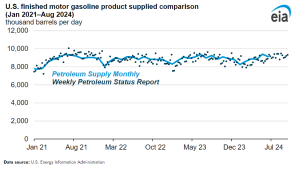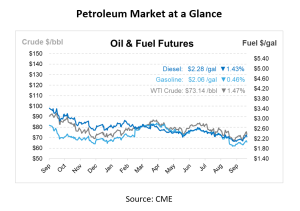
What’s That: Product Supplied
Our nation relies on and consumes many petroleum products that are part of our domestic market. The sources of these petroleum products include refineries, natural gas processing plants, blending plants, pipelines, and bulk terminals. Have you ever considered what the accurate U.S. consumption of petroleum products looks like and how it’s calculated? Product supplied surveys of primary petroleum suppliers determine the volume of refined petroleum available for domestic consumption. In today’s article, we will dive into what it is and why it is a necessary calculation for the energy industry.
What is Product Supplied?
Product supplied in the energy industry is a measure of the volume of petroleum products, such as gasoline or diesel, that are delivered out of the primary supply chain (e.g., refineries, terminals, pipelines) into the marketplace. It serves as a proxy for consumption, though it does not directly measure retail sales or final use by consumers. Instead, it tracks how much of the product is available to meet demand from primary sources.
Week-to-week changes can be misleading due to supply chain movements, such as business decisions to transfer gasoline between storage facilities or timing shifts in imports and exports. These fluctuations, especially around holidays like Memorial Day or Thanksgiving, may not reflect actual consumer demand.
To get a clearer view of long-term trends, analysts often use a four-week rolling average, which smooths out short-term variations. Broader factors like retail prices, economic conditions, and weather also influence gasoline demand.

How is Product Supplied Calculated?
It is used as a proxy for consumption because it measures the volumes of petroleum products that leave the primary supply chain before distribution. The product supplied for each petroleum product during a specific period is calculated by adding field production, refinery output, imports, and unaccounted-for crude oil (along with net receipts if calculated for a PAD District). From this total, stock changes, crude oil losses, refinery inputs, and exports are subtracted. The approximate calculations can be found in the EIA’s Petroleum Supply Monthly report, accessible on their website.
Overall, by actively monitoring product supplied, companies can make data-driven decisions that align their operations with actual market needs, ensuring efficiency and supporting growth.
How Does Product Supplied Enhance the Market?
You might wonder how it affects or enhances the market and how it influences market predictions moving forward. Generally, product supplied enhances the market by providing a clear measure of demand and consumption trends for petroleum products, which is valuable for planning and strategy in the energy industry. By understanding and analyzing it, stakeholders gain the ability to gauge current market dynamics and make informed predictions about future supply-demand shifts, enabling strategic decision-making in areas like pricing, production, and marketing initiatives.
Since product supplied measures the disappearance of petroleum products from primary sources, companies can assess the real market demand for fuels, lubricants, and other products, adjusting production and import strategies to meet consumer needs efficiently. It also provides market insights, indicating economic activity and consumer behavior. For example, an increase in product supplied for gasoline might suggest higher vehicle usage, which could correlate with economic growth or changing travel patterns.
Product supplied is more than just a number; it’s a valuable tool for understanding market behavior and making informed decisions that enhance efficiency and stability in the energy industry. This makes product supplied a useful metric for both macroeconomic planning and individual business strategy.

According to the EIA chart above, the current level of finished motor gasoline product supplied as of September 27, 2024, is 8.521 Mbpd, down from 9.2 Mbpd last week and 8.619 Mbpd last year. This is a net change from last week of -7.43% and -1.14% from last year.

This article is part of Daily Market News & Insights
MARKET CONDITION REPORT - DISCLAIMER
The information contained herein is derived from sources believed to be reliable; however, this information is not guaranteed as to its accuracy or completeness. Furthermore, no responsibility is assumed for use of this material and no express or implied warranties or guarantees are made. This material and any view or comment expressed herein are provided for informational purposes only and should not be construed in any way as an inducement or recommendation to buy or sell products, commodity futures or options contracts.





